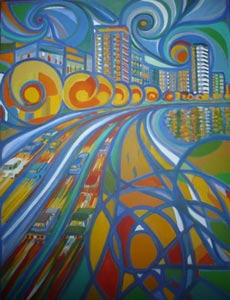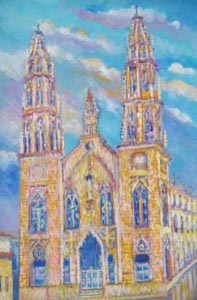D.P.
I recently had the opportunity of meeting him at his school-workshop-home, located next to Los Pasionistas Church, in La Vibora. When I reviewed a CD with information on his work, I got surprised by his singular capacity to unfold himself in different styles, what might initially have any specialist confused, or at least darken the way to the comprehension of artworks.
When I talked to Calafell (Havana, 1936) all doubts faded away. It was all about a hazardous and multiple story, which was retaken in every phrase or proposal, instead of being ended. I found a boy within the body of an adult, with enough energy to keep on reinventing himself, sometimes playing the leading role in the story, or the supporting actor, practically never as a mere observer.
 His relation with art began, as he points out, “by chance.” He studied commerce, typing, tachygraphy and English. “I studied commerce for my father, who didn’t understand the vocation for art. However, I studied piano for a long time and was always interested in painting. As the matter of fact, I took my first steps into that expression with my father, who –as hobby– painted portraits of refugees. He was good at working the watercolor and trained me in that technique. I learned the mystery of color from a neighbor, who used to pass by my door, saw me painting and taught me his notions on the treatment of pigments.”
His relation with art began, as he points out, “by chance.” He studied commerce, typing, tachygraphy and English. “I studied commerce for my father, who didn’t understand the vocation for art. However, I studied piano for a long time and was always interested in painting. As the matter of fact, I took my first steps into that expression with my father, who –as hobby– painted portraits of refugees. He was good at working the watercolor and trained me in that technique. I learned the mystery of color from a neighbor, who used to pass by my door, saw me painting and taught me his notions on the treatment of pigments.”
“You must know where you come from and where you are standing so you can know where you are heading to. The family history is very important for me, as my education is based on that. I come from a poor family. My grandmother was a servant; I don’t remember whether she was a cooker or a valet. She got me used to going to the theater and admiring dance groups and the zarzuela. She was a simple person, but there was a sort of culture within her that sometimes can’t be found in people who have studied. I had a typesetter uncle, who used to stand in front of the radio, just as he could see into her, so as to listen to symphonic music; and there was another who a mailman and loved trova. My godmother was a dressmaker, a native from Havana that transmitted me the passion for this city.”
“My mother was such a religious woman that visited seven churches in the city on Holly Friday. That was how I became interested in architecture, the shapes, and the atmosphere around these worship spaces. I admired the scenes of anxiety, pain, reflected with tremendous realism in order to created deeper devotion. I especially liked the baroque creation, not only in churches, but also in houses and objects that caught the eye from the streets: streetlamps, curbs, bars, grills.”
The Cuban Revolution encouraged Calafell to get professionally involved with art. So he began to study painting, during the nights, at San Alejandro, where he was seen by many as a “weirdo”, as he worked in a warehouse while most of them came from the ICAIC or other institutions linked to the culture. Afterwards, he became enthusiastic about engraving and sculpture, and continued studying in spite of the multiple challenges he had to face.
 He also followed the changes in terms of education, as he joined the programs of artistic teaching, in different levels. He started this work during the professional practices when Rafaela Chacon urged several students to collaborate by teaching second-cycle children. It was her who marked his destiny in that time when she told him: “You are a teacher.” After these first steps, he went to Makarenko School where he was head of department in that specialty, leading, as he said, “a small crazy army.” Later on, he devoted his time to his work in penitentiaries, a totally different but enriching experience. In that moment, there was no artistic teaching as university degree and Calafell was one of the people who contributed to the structuration of a methodology for all levels.
He also followed the changes in terms of education, as he joined the programs of artistic teaching, in different levels. He started this work during the professional practices when Rafaela Chacon urged several students to collaborate by teaching second-cycle children. It was her who marked his destiny in that time when she told him: “You are a teacher.” After these first steps, he went to Makarenko School where he was head of department in that specialty, leading, as he said, “a small crazy army.” Later on, he devoted his time to his work in penitentiaries, a totally different but enriching experience. In that moment, there was no artistic teaching as university degree and Calafell was one of the people who contributed to the structuration of a methodology for all levels.
In the middle of this whirl of work, the creation passed to a second position, because he didn’t have enough time to devote to that activity. “I could only paint on the October 10s and late night. It’s now when I’m an old man that I have been able to totally devote mi time to art.”
Calafell told me that, since the time in San Alejandro, he was interested in painting a portrait of his home city, and he tried different ways of showing it as years passed. He presently works on an impressionist Havana, with specific atmospheres in different moments of the day, just like Monet’s way. A special space is occupied by the religious buildings that impressed him so much, specifically Los Pasionistas Church, though as he affirms, there are other important sites: “Casablanca, I’ve liked it since I went there with my grandmother, Regla, Guanabacoa, Fuente de la India, Reina’s Church, and the Presidential Palace. All these elements could fulfill my impressionist view of Havana.”
 “Havana is made up of its bell towers, red tiles, stones, dark streets, light changes at different hours, wet streets characterized by their sonority, the acoustic of their paving stones, the sea smell, cumin, laurel, clove, cinnamon, onion, garlic, the color, the light effects of colonial skylights. That’s a spirit feedback.”
“Havana is made up of its bell towers, red tiles, stones, dark streets, light changes at different hours, wet streets characterized by their sonority, the acoustic of their paving stones, the sea smell, cumin, laurel, clove, cinnamon, onion, garlic, the color, the light effects of colonial skylights. That’s a spirit feedback.”
“I’ve spent most of my life practically away from art, at least when I had more potential” –Calafell affirms with certain regret. But he’s not giving up; he devotes his time to his work as professor, and his painting. He’s, undoubtedly, an academic artist, a cultured man. He has a future to follow.
For further information write to galeriascalafell@yahoo.com










